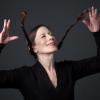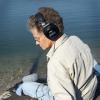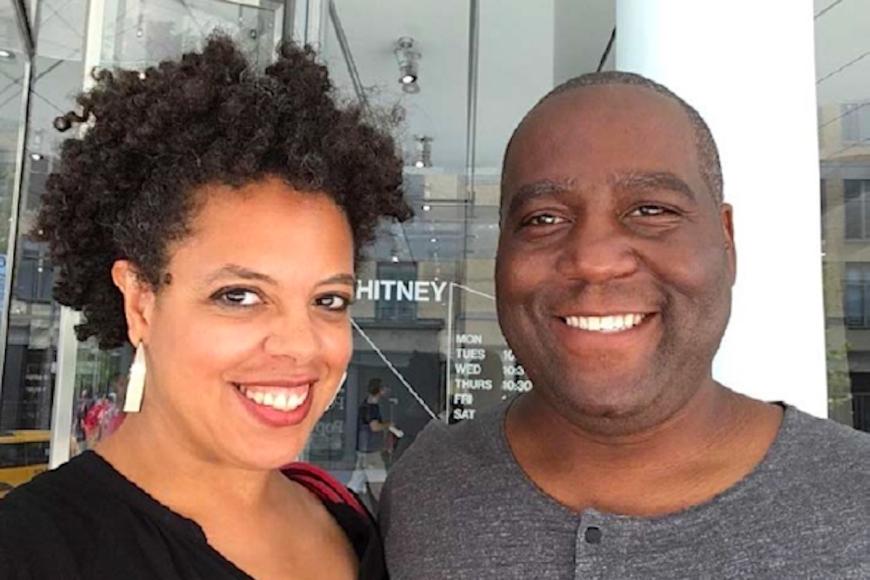
In the days following a conversation with Mendi and Keith Obadike and seeking to offer a gateway into their work, it occurs to me to suggest thinking of one’s name and age. These clustered personal letter sounds and numbers form a relatable point of access. Your name, after all, holds your birth story, ancestral history, gender associations, lineage relating to race and ethnicity, perhaps family spiritual practices, or geographic origins. Your age is a minimal, transitory piece of abstract data from which emotional and behavioral narratives and physiological and psychological profiles can be derived.
Similarly, the music, literature, and art produced by Mendi and Keith in works that encompass opera, new media, large-scale public art, museum sound installations, books, CDs, and more, unfold from similar data that is then spoken, sung, manifested instrumentally, manipulated electronically, or transformed into visuals. The resulting sounds and images tell stories of communities, societies, protest movements, tributes to writers, the legacies of musicians and civil rights leaders of the African diaspora, and celebrations of global cultures and traditions.
This artistic team will present The Bell Rang as part of the Mills Music Now Concert Series. The installation will be in place Nov. 18–21, and the pair will offer an online presentation about the work on Nov. 20.
The installation includes bell sounds and voices singing text drawn from the autobiography of Congresswoman Barbara Lee, also a Mills College alum. The text addresses the days following the 9/11 attack on the United States when Lee alone voted, counter to her colleagues in Congress, to oppose the broad congressional authorization for the use of military force.
The Obadikes have had long careers creating sound art, dating back to the 1990s. Some of their early work, including the opera The Sour Thunder and Crosstalk: American Speech Music have been captured on Bridge Records. In addition to albums and sound art installations, the duo has created public art, published poetry and books, and pieces that they call “opera-masquerades,” “works that deal with myth, music, and theatrical performance.”
For The Bell Rang, what can you tell me about the score and about the bell and its inherent tonalities, textures, and other qualities that were your focus?
Keith: We don’t always produce a score, unless we’re working with lots of other people. With a small group, we do it orally. In this case, we’re working with film recordings we made in the studio. We have a large bell plate we made ourselves; a 46-inch bell plate made of steel we used to make our bell sound, a kind of circular thing. It sounds like a church bell. We start with that and tune it in various ways to make the piece. How the piece works itself, it’s a fairly short cycle we’re doing slowly over time. It’s a two-and-a-half-minute cycle that repeats twice with multiple voices singing text — that short phrase you hear. The voices and the bell are approximately the same amplitude.
The actual bell sound: what attracted you to it?
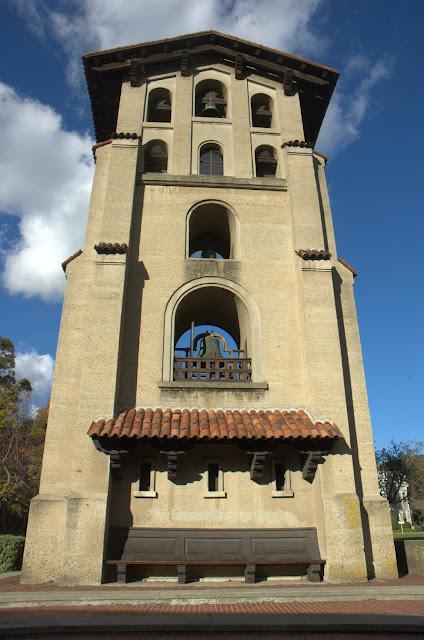
Keith: What we liked about church bells and these particular kinds of public signals is that they are so many things at once for people. They can be nostalgic, romantic, ominous, formidable. It can be all of these powerful things and then can be put in background. It’s an amazing cultural thing that comes from people hearing it over lifetimes. We’ve done a few projects where we have reworked the idea of church bell, or made it slightly unfamiliar. In this case, we’ve used a voice to talk about another kind of bell ringing.
Mendi: We’re referencing kinds of bells: there’s the bell of the piece, there’s the bell in the bell tower (the text is projected onto the Mills College El Campanil bell tower), there’s the bell Barbara Lee references in her text. We’re interested in the interplay between those three.
The same topic applied to the voices: What is frontal, off-centered, or in other ways explored?
Keith: We’re used to people thinking of this church bell sound as something we hear in public, something we can’t ignore. The voice, it makes it new. The voice was recorded in close proximity so when we hear that at the loud volume of a church bell, that makes you hear it and pay attention. “What are these voices saying?” We hope it makes people ask, “What’s being communicated with me?” The bell is there to tell us something; the voices will explain what that message is.
Mendi: We also deal with time somewhat differently in musical pieces. What is a short phrase is meted out over time and the voices make that possible. You’re hearing the phrase over time and because the voice has melody, you are having a different experience of the language than if you were just having the words said to you. That, for us, is a space of meditation. Music can change our relationship to the words and in changing the pacing, allow us to think and feel differently.
Keith: What Mendi is referring to in this piece is that sometimes the language will feel like it’s resolving in the middle of the phrase but it will be clear that harmonically the piece is not done yet. At other times, it feels like it is harmonically dissolving and pulls the language in some way. Playing with that tension between language, melody, and harmony invites people to listen in different ways from how we listen to melodic phrase on its own in a public space.
In considering the architecture of the words in the text as an element projected on the tower and conceptually, what thoughts come to mind?
Mendi: Architecture of text. I don’t know what you mean by that. What it suggests to me is something about the chart of ascendance. As we thought about melody, texture, and timing, what we realized is how we could break up the sentence and give real time to each part of it. The architecture of the language: I think about the moments in that way.
Keith: We spent time reading a lot of Barbara Lee’s writing not only in her [auto]biography but in many of her speeches. One thing that we were struck by is how her language is really, really direct. It’s precise and to the point. That is part of why we took this relatively short phrase and stretched it out. By slowing it down, it becomes abstract. By sitting with “The bell rang, votes were cast,” if you hear that over 45 seconds, it takes on a different quality. Sit with the word “cast” for 15 seconds and you can think about all the sounds in that word. Why is this piece of language hanging out like that? That’s part of the direct nature of Barbara Lee’s speech and her writing.
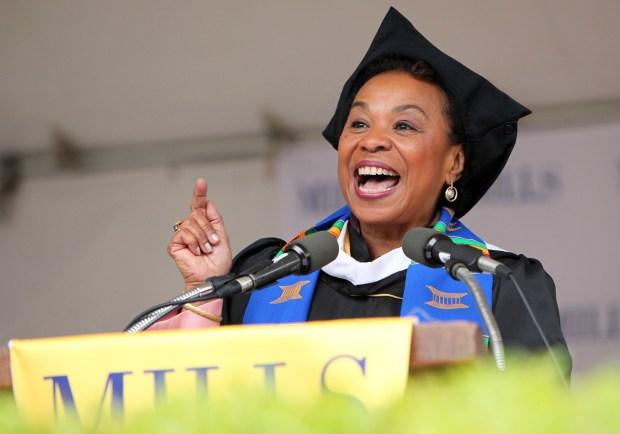
Mendi: In her language she says, “the board was full of green lights. There was only one red one.” In this case, although we think of green is go and red is stop — and it does mean that in some way — the green lights are sort of ominous. Because what it represents is that there were so many votes she had to stand up against. Although green is a color of prosperity, hope, and positivity, in this case it represents opposition. We had to think about what that means, what is the feeling of that in the music? That was something for us to solve.
Keith: What she’s calling for in that moment, with the statement, and what we are trying to capture is: Let’s take a pause, let’s reflect. That’s part of why we wanted to slow it down. Literally she’s saying, let’s slow down, let’s look inside the wisdom instead of going with the action of the moment. How do we convey reflection? It’s interesting because direct language is not something we associate with a pause for wisdom. But she is asking us to go inside. Other texts have said that [same thing] in some way. Not everybody would think of her vote as a spiritual call, but that’s how we perceived it. We wanted to shine a light on that.
The choice of location for the projection: What determined your choice to use the bell tower?
Keith: it’s a place where a public signal is already happening; something musical. You can think of a church bell as a political thing, musical, a signal. That space is already designated for that sort of thing and we’re just remixing its function on the campus. We wanted to think about not so much the person Barbara Lee, but what this moment of courage means in the culture, especially as Mills is changing. That courage is tied to that place, related to that place. A culture developed there. We thought this would be an interesting time to highlight that.
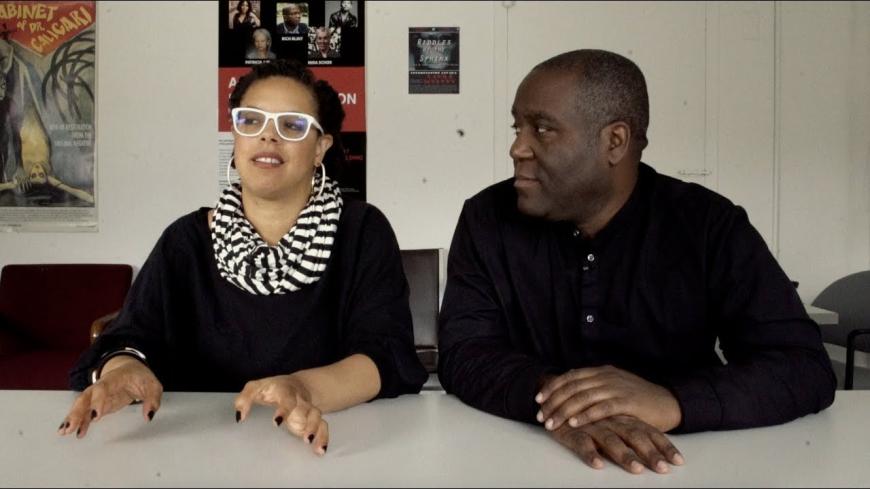
Thinking generally about public art, people have different proximity and physical scale relationships to the art and might have different purposes in experiencing it. To what extent do those considerations shape the project?
Keith: Thinking about space is central. That’s the starting place for us. You talk about human scale in relationship to architectural spaces or natural environments. That’s where we start. For example, we worked in Times Square, a place where a lot of people feel smaller. [They are] in the shadow of large buildings and advertisements. We did a piece for headphones, for a quiet voice and music made from the ambient space. You end up with something more intimate. When we’re listening to something in close proximity like that, we feel larger, we feel held close. In other ways, we might project sounds from a great distance and people listen, lean in, and that can be helpful to tell a certain kind of story.
Mendi, have your research practices changed over time or been influenced by specific projects or experiences?
Mendi: Every experience changes our research and art process. There are some enduring questions in our work. We’ve been working together for a long time, and since childhood I’ve been asking questions about dialogue in a piece; about language, sound, and African culture, as those things are in every part of my life. They are in this work, they are also in my dissertations, [and in] poems I wrote as a child. Those big questions about how sound and language can work together and the cultural resources I have to explore, those have been the same questions. But then, different projects along the way have taught me different things. Not that they’ve changed those questions, but they taught me different things about life, culture, relating to other people.
What have you learned about using data as a foundation for building a narrative?
Mendi: We have a project called Number Stations. What we do with several of them — so far we have three — with each of those projects, we take the numbers from some archive and sonify them and also perform them. The database we use represents stop and frisk numbers. In performing them and making the score from them, we need to figure out a way for each of us to have a different kind of number to perform. We know we are going to go back and forth. We have to figure that out without it being obvious. Figuring that out reveals how we might feel [about] or relate to those numbers.
In Manifests [Number Station 3, 2016], for example, those numbers are from slave ship manifests. The numbers are weight and height. So sometimes you come across a place where there should be a number but there’s no number. The reason is the person was so young they didn’t even record the weight. In performance, we actually think about the people we don’t have names for and what their experiences might be.
What I’ve experienced are feelings about people so young. And questions arrive about people so old. Over time, different questions about how to feel about different parts of the project come to mind. Going into performance with certain ideas — ideas I might not even have had while making the score — [emotions] come as I’m actually saying numbers. Each project has something like that: taking time to focus and have thoughts about your database and having feelings about it, is something we learn in the project.
Keith: Number Station, when I made it, I’m listening to myself, but I’m really listening to her. In focusing on the numbers, I’m less in a thinking space. I know what the project is about for us, but going deeper into reciting the database, the conscious part of my brain, that turns off. I’m completely in the feelings. I’m not so conscious of where all those feelings are coming from. I’m not conscious of thinking about the unnamed people or the very young or very old. I’m just completely in the emotion of the thing while reciting the numbers.
You spend a lot of time listening. Have you noticed aspects about how you listen in ways similar and disparately?
Mendi: My immediate answer about how Keith listens is I can see it on his face. When he’s listening to something he wasn’t listening to before, there’s a subtle change. I know he’s focused on something that he hears. I don’t know how to describe that shift in his face, maybe it’s an energy. The shift that happens when he’s focused, that’s always been an interesting thing to try to then listen myself and see what’s calling his attention. He listens very well in conversation with other people, something I’ve noticed because I can stand back and watch it. For decades, I have noticed what it’s like for him to focus his ears on something. I like that very much.
Keith: We listen in different ways; we key in on different things. Mendi has great melodic instincts. Those show up overtly in our musical projects. In day-to-day life, (it shows up) in a granular focus on speech and language. She notices subtle things in the way people speak. My brain couldn’t do this, but for her, she notices minor details in people’s speech melody, as well as language construction. She can do both of these things at the same time. It grew out of her musical training but it’s very natural for her. It shows up in our projects and to me it appears to be some kind of superpower.
The skills involved in attention or intentional focus, as you think about audiences in different environments and contemporary society: Do you observe universal features or prevailing advances or deficits in younger audiences?
Keith: I’m thinking about it generally. In every generation, there are forms that become popular. People might be consuming more short-format art, but plenty of people have the capacity to engage with long forms of all kinds. The dominant form I’m thinking of in this time is probably Instagram. Many people make images or 20-second stories for Tik Tok or Instagram. At the same time, long-form projects are booming in culture, like memoirs, so multiple things can be true at the same time.
Mendi: We are people who are interested in outliers. We both are more focused on what people say isn’t happening than what people say is happening. I don’t notice a trend in what people are capable of. I’m the person more interested in the exception to that rule.
The fluctuating relationship between art and science and audiences for which science has become so political: even abstract data can be manipulated. Does that enter your thoughts on art and science or impact your current projects?
Keith: The relationship of art and science appear in our work as through lines. We’re always dealing with these kinds of corners of human belief. Those [corners] are art, science, and religion or spiritual beliefs. We’re touching on those things because those are where people’s beliefs populate. Art hopefully makes us ask questions about what we believe. Science is something we can rely on and base our beliefs on. Some people base their beliefs on religion or on spiritual systems. All of these things work together even if it’s in the background. They form our core beliefs. We try to address those things in our own way. Science is powerful and provides thing for us, but these other aspects, they tug on each other. There’s a push and pull.
Mendi: The deeper we go into the questions we’ve had about science or how information is produced, we find out the creativity scientists are using. This creative element is always there. It makes us ask even more questions about what is this? Where is the line between science and art? We don’t always go there for that reason but we always find that question.


